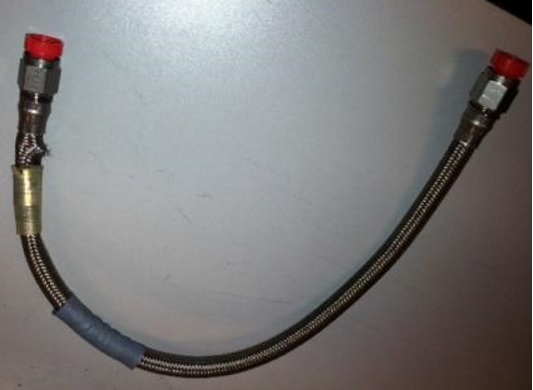What Leaks in Vegas Stays in Vegas – A320 Hydraulic Failure
The National Transportation Safety Board (NTSB) has recently issued a report on a Airbus A320 hydraulic failure incident. On 17 June 2012, a JetBlue Airways A320-232, N552JB, experienced a loss of two of its three hydraulic systems after departure from Las Vegas McCarran International Airport.
This incident is interesting because of the failure modes and effects, automation, crew workload and Service Bulletin assessment issues.

JetBlue A320 N552JB landing at Las Vegas – McCarran International (LAS / KLAS) 15 December 2012 (Credit: Tomás Del Coro, CC BY-SA 2.0)
The Flight
Before departure an inoperative slat flap control system (SFCS) number 2 flap channel was legitimately deferred in accordance with the Federal Aviation Administration (FAA) approved Minimum Equipment List. The NTSB report that:
During landing gear retraction after takeoff, the Green hydraulic system on the airplane lost pressure, and the flight warning computer detected a flight control flaps system fault followed by a reservoir overheat condition for the Yellow hydraulic system 2 minutes later.
The Blue hydraulic system was unaffected. However:
Normal inhibition of alerts and warnings from the flight warning computer prevented notification of the faults to the flight crew until the airplane was climbing out of 1,500 above ground level. The crew subsequently experienced a period of high workload as they received multiple aural and visual warnings on the flight deck.
At this point:
The captain, who was the pilot flying, transferred airplane control to the first officer and began to accomplish the abnormal procedures that were displayed on the electronic centralized aircraft monitor.
These procedures included turning off the engine-driven pumps for both the Green and Yellow hydraulic systems and the power transfer unit (PTU) which can mechanically exchange power between the Green and Yellow systems. This resulted in:
- Low pressure in the Yellow hydraulic system (leaving only the Blue hydraulic system with useable pressure)
- Reversion to the alternate flight control law with reduced flight envelope protections (most critically, stall protection)
- Autopilot and autothrust disconnection.
The NTSB report that:
The crew attempted to raise the flaps from position 1 (the takeoff position) to 0, but the flaps remained at position 1 because the loss of the Green hydraulic system and subsequent loss of the remaining flap control computer channel resulted in the flaps being inoperable.
The crew entered a holding pattern at 12,000 feet. With two inoperative hydraulic systems and the flap fault, the required landing distance was 11,000 feet. The captain recognized that the Yellow hydraulic system reservoir was no longer overheating and so was able to restore the Yellow system, which reduced the required landing distance to about 8,500 feet. Concerned about the high landing speed and the inability to raise the gear if they did need to go-around the crew remained in a holding pattern to burn fuel and made a safe landing 3 hours 35 minutes after takeoff.
The Investigation
A leak was found in the Green hydraulic system. The right main landing gear door retraction flexible pipe had failed due to a kink and collapsed sidewall.
The NTSB note that:
An article in the June 2007 issue of Safety First, Airbus’ safety magazine… described a scenario in which a leak in the Green hydraulic system results in that system’s loss of fluid, which can lead to the loss of the Yellow hydraulic system. As the hydraulic pressure decreases and reaches a 500 psi differential between the Green and Yellow system, the PTU, by design, automatically activates and operates at maximum speed in an effort to transfer pressure to the Green system. Due to low fluid levels in the Green system, the maximum speed of the PTU results in overheating and subsequent loss of the Yellow hydraulic system within about 2 minutes.
In this case the normal caution message that guides the flight crew to shut off the PTU was inhibited below 1,500 feet after takeoff. Similar incidents had occurred before. Consequently, Airbus issued Service Bulletins (SB) over the period of 2 to 5 years before this incident. These introduced that included wiring changes and new PTU inhibit logic to prevent dual Green and Yellow hydraulic system losses. The operator had decided not to incorporate the SBs based on available information indicating a low probability of occurrence for this type of event.
On training:
The company provided training to flight crews for hydraulic system malfunctions and failures during qualification training (QT) and during continuing qualification training (CQT). However, crews only received training on dual hydraulic system malfunctions during QT. At the time of the incident, CQT training focused on single system hydraulic malfunctions. Although interviews with company training management indicated that the company conducted training for multiple emergencies, the captain could not recall when he had received that training.
The failure of the right main landing gear door retraction flexible hydraulic line in the Green hydraulic system, which led to prolonged operation of the power transfer unit and subsequent overheating and loss of pressure in the Yellow hydraulic system, resulting in the airplane’s operation with only one hydraulic system. Contributing to the incident was the lack of incorporation of aircraft manufacturer service bulletins that describe procedures for aircraft modifications intended to prevent this occurrence.
Other Resources
See also:
- James Reason’s 12 Principles of Error Management
- Back to the Future: Error Management
- Aircraft Maintenance: Going for Gold?
- UPDATE 10 April 2016: C-130 Fireball Due to Modification Error
- UPDATE 9 January 2017: S-92A Flying Control Restriction on Wiring Loom
- UPDATE 24 June 2019: B1900D Emergency Landing: Maintenance Standards & Practices
- UPDATE 30 March 2019: Contaminated Oxygen on ‘Air Force One
- UPDATE 10 June 2020: B767 Fire and Uncommanded Evacuation After Lockwire Omitted
- UPDATE 30 June 2020: 17 Year Old FOD and a TA-4K Ejection
Aerossurance worked with the Flight Safety Foundation (FSF) to create a Maintenance Observation Program (MOP) requirement for their contractible BARSOHO offshore helicopter Safety Performance Requirements to help learning about routine maintenance and then to initiate safety improvements:
Aerossurance can provide practice guidance and specialist support to successfully implement a MOP.
This 14 April 2015 article by Aviation Week and Space Technology, on a different US A320 incident, featuring an uncontained V2500 engine failure, may also be of interest: Spirit Emergency Highlights Divide Between Training, Real Life



Recent Comments